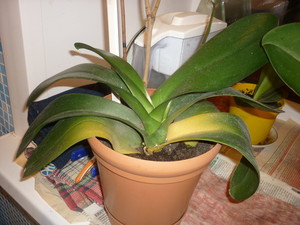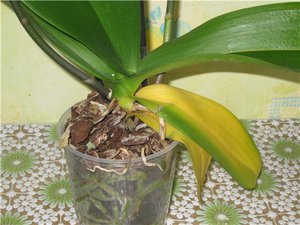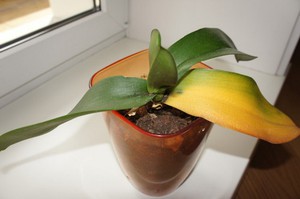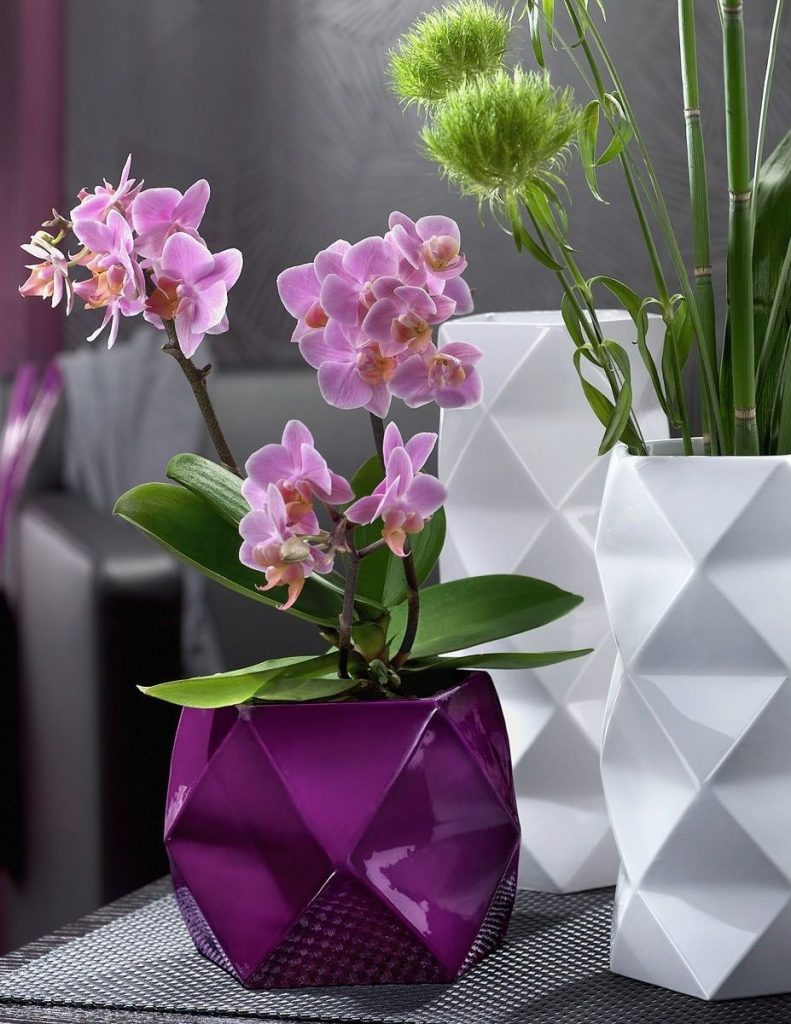Orchids are a fairly common indoor flower among amateur flower growers; they are a wonderful decoration for the house. The flower fascinates with its beauty, surprises with the variety of its forms and colors. Indoor orchid is a plant with a fairly thin stem, at the top of which is a luxurious flower.
Orchid variety
There are in nature about 30 thousand varieties of orchids, and at home you can grow only a few flowering species.
- Phalaenopsis is the most popular species among flower growers because of its unpretentious care. The flower petals of this orchid are very similar to the wings of a butterfly.
- Dracula is gloomy enough, but attractive in its own way orchid species.
- Paphiopedilum - its flowers resemble a shoe, flower growers appreciate it for its long flowering, reaching 2 months.
- Aganizia - This houseplant is very light-requiring and does not tolerate drought. It is popular because of the volumetric inflorescence (up to 5 large flowers).
- Wanda - this type of orchid grows up to 80 cm in height, etc.
At home, a florist needs take good care of the room beauty, otherwise this exotic capriciousness starts to hurt and her leaves turn yellow. Many caring housewives of a room orchid are worried about why this happens, but there are many reasons.
Why do orchid leaves turn yellow?
 It is enough to know all the reasons why the leaves turn yellow in order to prevent the death of your favorite plant.
It is enough to know all the reasons why the leaves turn yellow in order to prevent the death of your favorite plant.
The main causes of yellowing orchid leaves:
- natural yellowing;
- lack of light;
- plant burn;
- lack of light for the orchid;
- lack or oversupply.
Orchid leaves turn yellow, what should I do?
First of all, the plant begins to turn yellow due to the natural shedding of leaves. If one leaf has turned yellow or dried, and the rest are in the same state, then, as a rule, you should not worry, this means that the life cycle of this leaf has simply ended and a new one will soon form in its place.
If a leaf of a house flower begins to turn yellow from the tip, and not from the base, as it happens under normal conditions, then it does not have enough light. It is necessary to immediately solve this problem and rearrange the orchid to another window, where the lighting is stronger or additionally illuminated with a fluorescent lamp. If this is not done, then the stem will also begin to darken, and the plant may die.
When spots appear on the leaves, this is a sure sign that the indoor the orchid got burned... It could appear on a house plant from direct exposure to the sun's rays, from water droplets remaining on the plant after moistening (they "worked" as lenses under the sun's rays), even from a fluorescent lamp, if it is located low enough. The main thing is not to confuse burns with a fungus that grows throughout the leaf and begins to infect the orchid. With proper treatment, it can be saved.
If the leaves begin to turn yellow and become lethargic, then home the orchid lacks lighting... She is very thermophilic and loves bright light, but it must be diffused so as not to ruin the exotic beauty.To organize sufficient lighting when purchasing an orchid in a specialized store, it is imperative to clarify what type it belongs to - shade-tolerant or photophilous.
Also, the reason for the yellowing of the leaves of a flower may be a lack or an excess of nutrition. Perhaps the plant lacks potassium or iron, with a lack of them, the leaves turn pale and at the end they die off.
Optional indoor plant fertilized only during growth, as a rule, once every 3 weeks, purchasing specialized fertilizers for this, such as "Bona Forte". It is important to feed the plant only with specialized fertilizers; you cannot use fertilizers for other indoor plants. When a plant is transplanted into a specialized mixture, as a rule, this is done once every 2 years; it is not required to fertilize the flower for the first time, because it will receive all the nutrients from the substrate.
Harbingers of yellowing orchid leaves
If there is roughness on the leaves, destruction of the leaf tissue occurs, then you need to know that this is a harbinger - they will soon turn yellow. Need to eliminate the causebefore the leaves turn yellow yet. This requires:
 Provide the flower with abundant watering regularly, without flooding it. Watering your orchid is best done using a watering can to keep liquid out of the middle of the leaf outlet. But if, nevertheless, water did get there, then it must be removed immediately, preventing the plant from rotting.
Provide the flower with abundant watering regularly, without flooding it. Watering your orchid is best done using a watering can to keep liquid out of the middle of the leaf outlet. But if, nevertheless, water did get there, then it must be removed immediately, preventing the plant from rotting.- Transplant an indoor flower into a spacious pot. The dishes in which the orchid lives should not be small and cramped.
- Spray the flower and the space around it 1-2 times a day, especially during the heating season. Dry air can kill leaves in indoor orchids. For spraying, it is better to purchase a spray bottle and carry out the procedure until drops appear on the leaves.
Infectious diseases in orchids
Particular attention should be paid to yellowing of leaves due to infectious diseases. Unfortunately, quite often the orchid in the store is already amazed, so you should carefully examine the plant before buying.
Infectious diseases:
- Fungal
- Viral
- Bacterial
Signs of viral diseases are the appearance of light rings, ovals, yellow spots and stripes in the leaves of a flower.
The virus in a home orchid can live for a long time, while not showing itself in any way. But stress (if you create unfavorable conditions) can provoke a virus and, unfortunately, it will gradually affect the plant until it is completely destroyed.
Bacterial diseases are not dangerous, but they cannot always be completely cured. They manifest themselves as dark brown, black spots with a yellow rim. For treatment, it is necessary to isolate the orchid from other plants and cut out spots, treating wounds with activated carbon (if the disease is severely neglected, then the use of bactericides is necessary). With proper treatment and if no new spots appear after two weeks, the orchid becomes cured.
With bacterial rot, wet, dark yellow, brown spots can be seen on the leaves of a house flower. It is impossible to delay with treatment when such spots appear, if you start it, then the plant can no longer be saved. The spots begin to actively grow and turn black. If bacterial rot is detected, the place where the indoor flower stood (for example, the window sill and window) must be treated with hydrogen peroxide. A diseased indoor flower should be kept isolated from other plants until complete recovery.
 Fungal diseases received the greatest distribution among orchids, as they arise from the lack of proper care for it. They manifest themselves in different ways, including the appearance of dark yellow spots on the leaves. Some types of fungal diseases can be easily confused with a burn.Treatment for the fungus involves removing the damaged areas of the leaves, treating the cuts, and then, after the wounds have healed, the plant must be treated with a fungicide.
Fungal diseases received the greatest distribution among orchids, as they arise from the lack of proper care for it. They manifest themselves in different ways, including the appearance of dark yellow spots on the leaves. Some types of fungal diseases can be easily confused with a burn.Treatment for the fungus involves removing the damaged areas of the leaves, treating the cuts, and then, after the wounds have healed, the plant must be treated with a fungicide.
As it turned out, the reasons for the yellowing of leaves in indoor orchids are very diverse. If you follow the basic rules that this home beauty requires in care, you can avoid damage to the leaves. But if this happened, then by providing more careful supervision of the adorable orchid, the problem will disappear. In addition to leaving, you need to carefully consider the plant before buying and purchase it, preferably from trusted sellers of indoor flowers, because there is a very high probability buy an already infected flower, which will delight you with its beauty for a short time.


